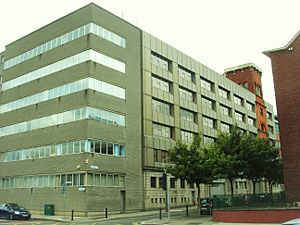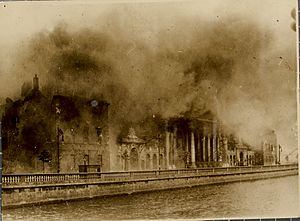National Archives of Ireland facts for kids
| Chartlann Náisiúnta na hÉireann | |
 National Archives offices on Bishop Street in Dublin |
|
| Agency overview | |
|---|---|
| Formed | 1988 |
| Preceding |
|
| Type | National Cultural Institution |
| Jurisdiction | Republic of Ireland, Government of Ireland |
| Headquarters | Bishop Street, Dublin, Ireland |
| Minister responsible |
|
| Agency executive |
|
| Parent department | Department of Tourism, Culture, Arts, Gaeltacht, Sport and Media |
The National Archives of Ireland (also known as Cartlann Náisiúnta na hÉireann in Irish) is where Ireland keeps its important government papers. It was created in 1986. Before that, two older offices, the State Paper Office (started in 1702) and the Public Record Office of Ireland (started in 1867), did this job.
In 1991, the Archives moved to its current home in Bishop Street, Dublin. This building is on the same spot where the Jacob's Factory once stood. Rebels used this factory as a base during the 1916 Easter Rising. The main goal of the National Archives is to keep important Irish records safe. They also make sure that people can easily look at these records. They hold documents from all over Ireland, including both the Republic of Ireland and Northern Ireland. Northern Ireland has its own archives called the Public Record Office of Northern Ireland.
History of Ireland's Records
The State Paper Office
Before the 1700s, government papers in England and Ireland were seen as personal property. This meant officials often took records with them when they left their jobs. To stop this, the State Paper Office was set up in 1702. Its job was to collect and keep government documents.
These papers mostly related to the Lord Lieutenants of Ireland. These officials represented the monarch in Ireland. The State Paper Office collected records about security, money, trade, land, and military matters. Until 1922, the State Paper Office was located in Dublin Castle. This castle was a key government building. In 1990, its contents were moved to the new National Archives.
The Public Record Office of Ireland
In 1867, during the time of Queen Victoria, the British Parliament created the Public Record Office of Ireland. This office was meant to collect government, court, and legal records that were more than twenty years old. A few years later, a law was passed to protect records from the Church of Ireland. These records were in danger of being damaged.
This new law also said that a "Master of the Rolls" would be in charge of protecting Irish records. This person could order documents to be moved to the records office. Copies of records could also be made and used as legal documents, as long as they were checked and approved.
The Public Record Office was first located in the Four Courts complex in Dublin. In 1922, during the Irish Civil War, the Four Courts was taken over by Anti-Treaty forces. On June 30, a huge explosion happened in the Public Records Office. Many old records, some dating back to the 13th century, were destroyed.
It was later discovered that the Anti-Treaty forces had stored their ammunition in the Public Records Office. When the Free State army attacked the Four Courts, one of their shells hit the ammunition. This caused the explosion. It took years to rebuild the Public Record Office, and it finally reopened in 1928.
Creating the National Archives
The State Paper Office and the Public Record Office worked separately for many years. But in 1986, the National Archives Act brought them together. This new law created the National Archives of Ireland. It officially started on June 1, 1988.
To give the archives a bigger space, the government chose a new location on Bishop Street in Dublin in 1989. The old State Paper Office moved there in 1991. The Public Record Office, now part of the National Archives, moved from the Four Courts to Bishop Street in 1992.
Under the 1986 Act, government departments must send any records that are thirty years old or older to the Archives. This allows the public to view them. Records that are not yet public must be reviewed every five years. This check decides if they can finally be released for everyone to see. The Act also created the National Archives Advisory Council and a Director to guide the archives.
How the Archives Work
Keeping Records Safe
The Archives Storage and Preservation Division takes care of all the records. Their job is to make sure these important documents last a very long time. They manage storage space, fix damaged documents, and make copies. They also plan for disasters to protect the records.
Because new government records arrive every year, this team makes sure there is always enough space. They also create computer databases to keep track of where everything is stored. To protect original documents from being handled too much, they make copies. These copies can be physical, digital, or on microfilm. This way, people can use the copies, and the originals stay safe for future generations.
This division also checks the buildings where records are kept. They make sure the buildings are strong enough to protect against floods or other problems. If a disaster happens, they have a plan to save or move important documents. Every day, this team also helps staff and visitors by getting documents from storage and putting them back safely. They use computers to track every movement of a document.
Helping Visitors
The Reader Services Division helps people who want to use the archives. They answer questions in person, by email, or over the phone. They also help people get copies of documents. This team creates online displays and shares news about the archives on social media. If you visit the Reading Room, the staff from this division will be there to help you.
Finding and Organizing Records
The Records Acquisition and Description Division finds and organizes new records for the National Archives. They follow international rules for how they describe and list documents. Since many government records are sent to the archives, this team decides which ones are important enough to keep forever. They also review and remove any records that are no longer needed.
Most records are paper, but some are digital. A special team called the Electronic Records Unit (ERU) preserves these digital files. This division also gives advice to government departments on how to manage and send their records to the archives.
While the archives mainly deals with government records, they also accept donations from private groups or individuals. They do this to add to their collections and save important documents that might otherwise be lost.
Special Projects
The Special Projects Division works on big projects, like turning old documents into digital files. They also work with other groups to publish important historical information. One of their biggest projects was putting the 1901 and 1911 census records online. This made it possible for people to search records from all 32 counties of Ireland.
This division has worked on many other projects, including:
- The Crowley Bequest website: A digital list of early papers from a very important collection.
- The Bureau of Military History website: This site has searchable stories from Ireland's revolutionary period.
- The Tithe Applotment Book (1823–1837): Images and names from old tax records.
Exploring the Collections
How to Access Documents
When you first visit the National Archives of Ireland, you need to get a Reader's Ticket. This ticket lets you enter the Reading Room and look at records. You will need a photo ID and proof of your home address. The ticket is good for three years, and you must show it each time you visit.
All records can be viewed for free. However, some might be restricted if they are too fragile or contain very private information. You don't need to ask for a record in advance if it's stored at the main building. But some records are kept in another location. If you want to see one of these, you must request it and come back another day when it has been delivered. Most records can only be viewed in person at the Reading Room.
Types of Records You Can Find
Many people visit the archives to find records for their family history. The archives has identified the most helpful records for this type of research:
- Births, Marriages, and Deaths:
- Records after January 1, 1864, can be found at the General Register Office.
- After 1922, records from the six counties of Northern Ireland are at the General Register Office Northern Ireland.
- Census Returns:
- A census of the Irish population was taken every ten years from 1821 to 1911.
- Sadly, most records from 1861, 1871, 1881, and 1891 are missing. Only a few from 1821, 1831, 1841, and 1851 remain.
- The census records for 1901 and 1911 are available online.
- Tithe Applotment Books:
- These books were created between 1823 and 1837. They helped the Church of Ireland calculate taxes from farmers.
- Griffith's Valuation:
- This printed book, published between 1847 and 1864, lists people who rented land and buildings. It also shows the value of the property.
- Wills and Testamentary Records:
- These include wills, lists of assets, and other legal papers about people's property after they died.
- Soldiers’ Wills
- Ireland-Australia Transportation Records (1791–1853):
- These documents relate to people sent from Ireland to Australia.
- Estate Records:
- These records can include legal papers about land, maps, rent lists, and letters.
- The National Archives has some estate records, but the National Library of Ireland and the Public Record Office of Northern Ireland have even larger collections.
- Private Source Records:
- These are private collections, often about wealthy families. They might include letters, deeds, maps, and other documents.
- Parish Records and Marriage Licences:
- Before 1864, churches were the main places that kept records of baptisms, marriages, and burials.
- Most original church records are still with their local parishes. The National Archives has some copies, but others can be found at the National Library of Ireland or the Public Records Office of Northern Ireland.
- Poor Law/Board of Guardian/Workhouse Records



